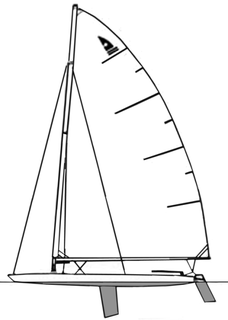
The Lightning is an American sailing dinghy that was designed by Olin Stephens of Sparkman & Stephens, as a one-design racer and first built in 1938.
The Comet, sometimes called the Comet OD or Comet One-Design, is an American sailing dinghy that was designed by C. Lowndes Johnson as a one-design racer and first built in 1932. The design has evolved over time via modifications.

The Jet 14 is an American sailing dinghy that was designed by Howard Siddons as a one-design racer and first built in 1952.
The A Scow is an American scow-hulled sailing dinghy that was designed by John O. Johnson as a racer and first built in 1901.
The MC Scow is an American sailing dinghy that was designed as a one-design racer and first built in 1956.

The C Scow is an American sailing dinghy that was designed by John O. Johnson as a one-design racer and first built as early as 1905. Sources disagree as to the first-built date, with claims of 1905, 1906 and 1923.

The M Scow, also called the M-Scow and the M-16 Scow, is a Canadian/American sailing dinghy that was designed by Johnson Boat Works and Melges Boat Works as a one-design racer and first built in 1950.

The Lido 14 is an American sailing dinghy that was designed by Barney Lehman and William D. Schock and first built in 1958.
The Rhodes 19 is an American trailerable day sailer or sailing dinghy, that was designed by Philip Rhodes as a one-design racer and first built in 1958.

The Windmill is an American sailing dinghy that was designed by Clark Mills as a one-design racer and first built in 1953.

The X Boat, also called the Cub, is an American sailing dinghy that was designed by John O. Johnson as a one-design racer and first built in 1932.
The Coronado 15 is an American sailing dinghy that was designed by Frank V. Butler as a one-design racer and first built in 1968.
The Irwin 41 is an American sailboat that was designed by Ted Irwin as a cruiser and first built in 1982.
The Nacra 5.2 is an American catamaran sailing dinghy that was designed by Tom Roland as a one-design racer and first built in 1975. Other that the small production run Nacra 36, the Nacra 5.2 was the first Nacra brand boat and established its reputation.
The Skipjack 15 is an American sailing dinghy that was designed by Harry R. Sindle and Carter Pyle and first built in 1965.
The Designers Choice is an American sailing dinghy that was designed by Sparkman & Stephens as a sail training and racing boat and first built in 1978. It was Sparkman & Stephens' design #2349.
The AMF Apollo 16 is an American sailing dinghy that was designed by Canadian Bruce Kirby as a one-design racer and first built in 1977.
The Isotope is an American catamaran sailing dinghy that was designed by Frank Meldau as a one-design racer and first built in 1962.

The Hampton One-Design is an American sailing dinghy that was designed by Vincent Serio as a one-design racer and first built in 1934.
The Prindle 18 is an American catamaran sailing dinghy that was designed by Geoffrey Prindle as a racer and first built in 1977.











